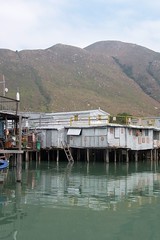 The last third of our trip around Malaysia was spent in the Malaysian part of Borneo. The plan was simple – get into the jungle and experience the wonderful nature (without sacrificing too much comfort and getting too many mosquito bites). Unfortunately we knew very little of Borneo and our guide book wasn’t helping enough. Anyhow, we flew from Langkawi to Kuching, main city of the Sarawak region of Borneo, via Kuala Lumpur. We were quite stressed out as we had booked flights without much time in between and AirAsia, our airline, didn’t offer any help, they just told us that we should have taken other flights.
The last third of our trip around Malaysia was spent in the Malaysian part of Borneo. The plan was simple – get into the jungle and experience the wonderful nature (without sacrificing too much comfort and getting too many mosquito bites). Unfortunately we knew very little of Borneo and our guide book wasn’t helping enough. Anyhow, we flew from Langkawi to Kuching, main city of the Sarawak region of Borneo, via Kuala Lumpur. We were quite stressed out as we had booked flights without much time in between and AirAsia, our airline, didn’t offer any help, they just told us that we should have taken other flights.
We made it through, but in the process I happened to be a victim of the well known “glass-bottle-in-the-bag-with-smelly-contents-break-in-luggage-handling”. It was not any bottle, it was a bottle of Langkawian herbal oil that doesn’t smell good but smells a lot. My bag could be noticed from several meters away and the check-in lady refused to take it without further sealing – so I got it completely wrapped up in plastics. The damage from this chemical catastrophy was not too bad after all though, but one of my books will forever have a scent of Langkawi as well as brown pages instead of white. ‘Nuff said.
Anyway, Kuching was not much of a city. We had to look for hours after decent restaurants and although the city claimed to be tourist oriented it seemed to have forgotten us tourists in the middle of January. We lived on a quite fancy hotel, the Harbourview Inn, but where not overly impressed although the standards were good. We ate at an italian restaurant at a nearby luxury hotel and payed as much as any normal Hong Kong restaurant would charge us, which was nice. We didn’t want to waste too much time in Kuching though, so after much decision anxiety we ordered a two-day trip into the jungle, to Lemanak.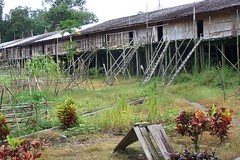
Basically, we were picked up at the hotel by a nice and talkative guide, which first took us to an orangutang center. We saw very few orangutangs – it started raining when they started arrive and we made a pitiful escape without any decent photos to show of the amazing primates (their way of getting through the jungle in the tree tops is just awesome). We then continued to a river and switched to long, narrow river boats to get to our destination, the Iban village of Lemanak.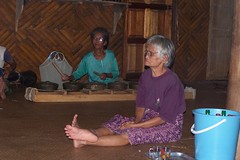
We had expected really primitive conditions, headhunter warriors and similar stuff, but soon enough we understood the truth were a bit different. The village was receiving tourists each day and had a special longhouse for them with decent standards, even showers and kitchen. The main long house was used for selling handicraft, although most of it wasn’t made by the villagers – it was imported and sold for higher prices than in Kuching. They had a phone, and their houses was decorated as any normal home in the area. Even though all this took away some of the feeling it was still special – the villagers were mostly old people with strange tatoos drinking rice wine (and offering us). They showed us traditional dances and ended up partying with us thanks to a couple of bottles of local rice wine. The next morning we were shown a cock fight, we tried blow pipe (surprisingly easy to use!) and made a jungle walk to see all the medicinal plants and traps that the people used. All in all, it was a nice experience with a really nice guide!
After the trip to Lemanak, we started to look over our budget. It was not looking good, so we chose to try and do the rest of the trip on our own with budget alternatives (a decision we later didn’t follow at all). So we took a night bus across Sarawak to the town of Miri, portal to the great Mulu National Park with it’s famous jungle and caves. The bus ride was not just any bus ride, it was a 14 hour bus ride in total darkness and with winter climate inside due to fierce air conditioning. The only light came from the police road blocks that we encountered (and every time a serious police officer entered the bus and looked closely at our pass ports). It was a bit hard to sleep…
After the grueling night we took a Fokker 50 from Miri to Mulu and ended up in a house that, according to the sign, was an airport. You have to understand that Mulu National Park has two hotels, two roads and nothing more. It is apparently not possible to drive to Mulu from anywhere (but I wonder how they got their cars there…). The only way is flying (no, there is another way… read below…). We had heard that Mulu had a great and cheap luxury resort, Royal Mulu, so we jumped on their van from the “airport” and ended up in an amazin resort (of which I have no pictures!). We payed around 10-12 Euros per night and person for 4-star standards. As time went on though, we realized where the resort got their income – expensive food and insultingly expensive arranged tours.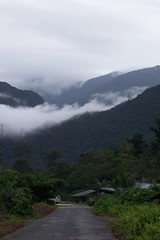
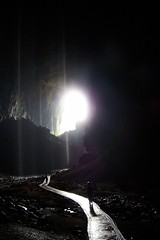 We decided to skip the hotel tours and walked to the park office, where they offer the same tours as the resort, but for a tenth or less of the cost. So we went. And we saw amazing caves and jungles. I can’t make justice to the park in text, and probably not in the photos either. You should just go there, but I can throw some facts at you: Deer Cave, the biggest cave passage in the world (supposedly big enough to containt St Peters Cathedral in Rome) with 3 million bats that flies out every evening; Clearwater Cave, 108 km long with an underground river all the way; Cave of the Winds with strong winds going through, a fantastic hole right up to the sky and the “King’s Chamber” made of stalagmites.
We decided to skip the hotel tours and walked to the park office, where they offer the same tours as the resort, but for a tenth or less of the cost. So we went. And we saw amazing caves and jungles. I can’t make justice to the park in text, and probably not in the photos either. You should just go there, but I can throw some facts at you: Deer Cave, the biggest cave passage in the world (supposedly big enough to containt St Peters Cathedral in Rome) with 3 million bats that flies out every evening; Clearwater Cave, 108 km long with an underground river all the way; Cave of the Winds with strong winds going through, a fantastic hole right up to the sky and the “King’s Chamber” made of stalagmites.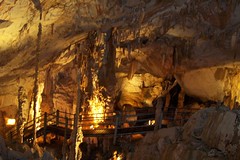
So, where exactly did this part of the trip get so disappointing? Actually, right here. After going through the caves we had to start thinking about leaving, we had a plan to catch in Singapore (to HK) two days later. Unfortunately we hadn’t booked the flights to get from Mulu to Singapore via Miri. And here the trouble began – the Mulu->Miri flight was cancelled and then fully booked. The earliest flight from Mulu would only connect to one flight from Miri, which was fully booked (due to the Chinese New Year). We just realized we had a quite expensive ticket for a Singapore-HK flight which we wouldn’t get to and suddenly and unwillingly we had to extend our budget. How did we solve it? Listen to this:
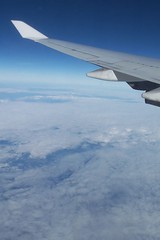 We went up at 2 AM in the morning of the 27th January. At 3 AM we left with a chartered longboat down the river in complete darkness (an extremely expensive boat, by the way). At 5 AM we arrived at the first hint of civilisation, the stop for the regular river boat service. We switched boat, waited for a long time and then started our next part of the trip down river. At 10 AM (!) we arrived at the first town, were we switched to the next boat. At 12 AM we finally arrived at the mouth of the river, and we switched to taxi to Miri. Why? To buy an airplane ticket we had called about last night from Brunei to Singapore. Unfortunately the ticket we wanted couldn’t be bought there but they had it at the Brunei Airport for double the price. So, now we called a taxi to go to Brunei, were we arrived after much trouble in the border control at 5 PM. The flight left at 7 PM to Singapore, and at 9 PM we went to “bed” in a chair in Pacific Coffee at the Changi Aiport, Singapore. The flight from Singapore left at 7 AM and finally we arrived in HK at 11 AM. The whole effort, not including the Singapore-HK flight, costed us around 300-350 Euro, probably more than all previous travel costs combined. So children, learn this – book your flights home well in advance when you go traveling!
We went up at 2 AM in the morning of the 27th January. At 3 AM we left with a chartered longboat down the river in complete darkness (an extremely expensive boat, by the way). At 5 AM we arrived at the first hint of civilisation, the stop for the regular river boat service. We switched boat, waited for a long time and then started our next part of the trip down river. At 10 AM (!) we arrived at the first town, were we switched to the next boat. At 12 AM we finally arrived at the mouth of the river, and we switched to taxi to Miri. Why? To buy an airplane ticket we had called about last night from Brunei to Singapore. Unfortunately the ticket we wanted couldn’t be bought there but they had it at the Brunei Airport for double the price. So, now we called a taxi to go to Brunei, were we arrived after much trouble in the border control at 5 PM. The flight left at 7 PM to Singapore, and at 9 PM we went to “bed” in a chair in Pacific Coffee at the Changi Aiport, Singapore. The flight from Singapore left at 7 AM and finally we arrived in HK at 11 AM. The whole effort, not including the Singapore-HK flight, costed us around 300-350 Euro, probably more than all previous travel costs combined. So children, learn this – book your flights home well in advance when you go traveling!
 Chinese New Year is a really big event all over China. It’s the end of the lunar year and this time it became the year of the dog. A whole set of traditions (or call it “superstition”) comes with the CNY. The most important is to spend time with family and relatives. So I did that, or more correctly, I spent time with Shirley’s family during a weekend on Lantau Island.
Chinese New Year is a really big event all over China. It’s the end of the lunar year and this time it became the year of the dog. A whole set of traditions (or call it “superstition”) comes with the CNY. The most important is to spend time with family and relatives. So I did that, or more correctly, I spent time with Shirley’s family during a weekend on Lantau Island.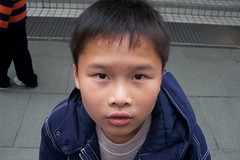 Basically, it all started with a “yam cha”, a lunch of dim sum with around 10 people. Shirley’s sister Jenny brought her puppy dog Bi-Bi which made it much more interesting (otherwise it’s not very entertaining as everybody else in the family speaks cantonese). Dim sum is very traditional Hong Kong food, and it’s basically lots of small dishes, often dumplings or small buns, most of them steamed. I like some of it and dislikes lots of it, which is my general approach to chinese food. But it can be really good if I know what I order (and Shirley did as always a great job translating for me).
Basically, it all started with a “yam cha”, a lunch of dim sum with around 10 people. Shirley’s sister Jenny brought her puppy dog Bi-Bi which made it much more interesting (otherwise it’s not very entertaining as everybody else in the family speaks cantonese). Dim sum is very traditional Hong Kong food, and it’s basically lots of small dishes, often dumplings or small buns, most of them steamed. I like some of it and dislikes lots of it, which is my general approach to chinese food. But it can be really good if I know what I order (and Shirley did as always a great job translating for me).